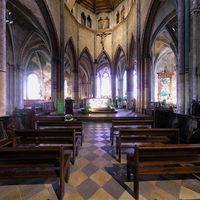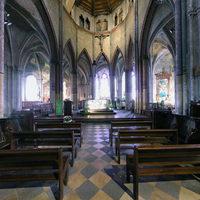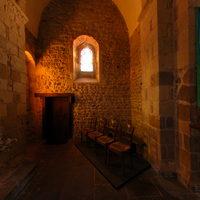Overview
Church of Ste-Croix. Gregory of Tours tells the story of the slave Porcianus who had miraculously saved the population of Auvergne from the ravages of Thierry, son of Clovis, in 522. Saint Pourçain became a monk, then abbot. The monastery that was established at the end of the 9th century was thought to enshrine the site of this saint's tomb. Charles the Bald gave the monastery in 871-5 to the monks of Noirmoutier who were fleeing the Norman invasion, carrying the body of Saint Philibert with them. The monks continued on to Tournus where they established the great monastery to which S-Pourçain was subordinated. The monastery of S-Pouçain was reconstructed in the mid-10th century. The existing church defies conventional descriptions since it results from an extended succession of mismatched campaigns. The earliest part of the structure can be found in the triple-aisled porch which forms the base of the west tower which may go back to the eleventh century. The nave was rebuilt presumably soon afterwards--the outer walls of the western bays still remain. Projecting pilasters on the outer wall have suggested (Prache) that the old nave had aisles with groin vaults. In the 1160s century work began on a new transept and choir with a crown of shallow radiating chapels distantly inspired by northern monuments including S-Denis, S-Germain-des-Pres and Noyon. The lower north transept and two northern chapels belong to this campaign. It had probably been intended to construct four chapels with no axial chapel as was common in the Auvergne; however, this plan assumed a considerable lateral expansion of the body of the church. Such expansion was impossible owing to the resistance of the townsfolk to the displacement of the road to the north and owing to the expense of rebuilding the monastic buildings to the south. Work lapsed and when it was renewed almost a century later (c. 1240, two more radiating chapels, hemicycle and south choir aisle) an attempt was made to introduce a five-segment plan more characteristic of northern monuments--the result was a dramatic misalignment. Presumably for lack of money and lack of control of the site progress was slow: the upper choir remained unfinished and the the attempt to push work into the nave failed because of the over-ambitious span of the arcade. The decision was made to employ the outer wall of the old nave and leave the upper story unfinished under a wooden vault. The choir of S-Pourçain marks the appearance of Gothic in the Bourbonnais. Such an appearance marks not so much the triumph of architectural form on its own merits, but may be understood as a sign of the increasing interest of the king of France, Louis VI, in this area. In 1108-9 the king had laid seige to the usurper Vaire-Vache in his château at Germigny; the king assumed a direct role as protector of the monastery of S-Pourçain.



